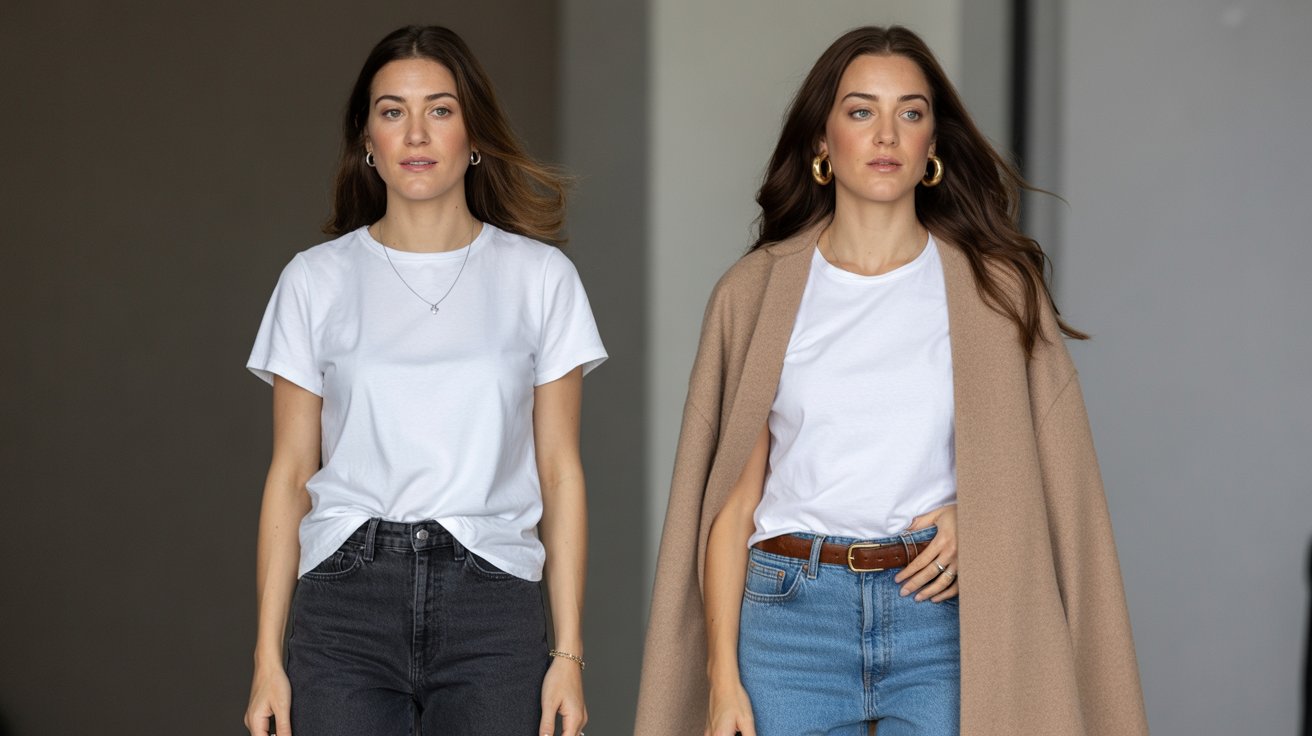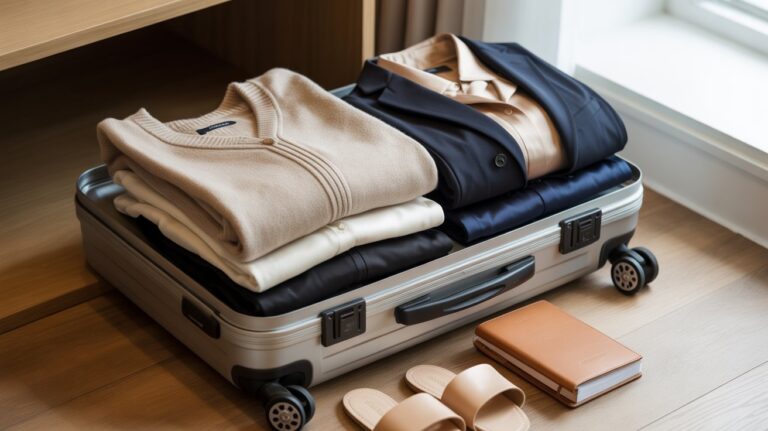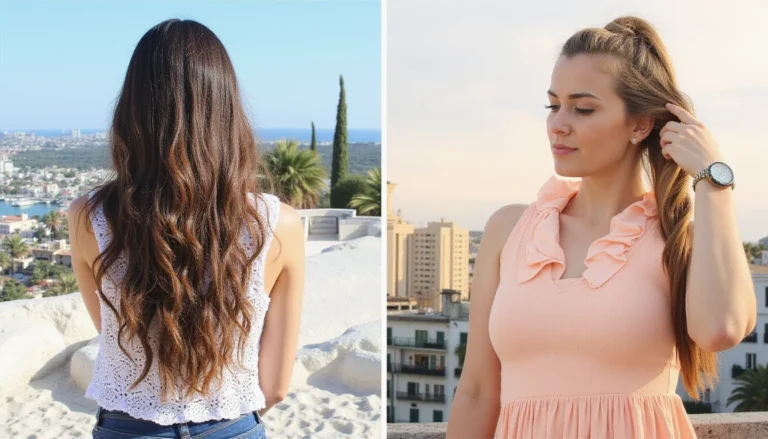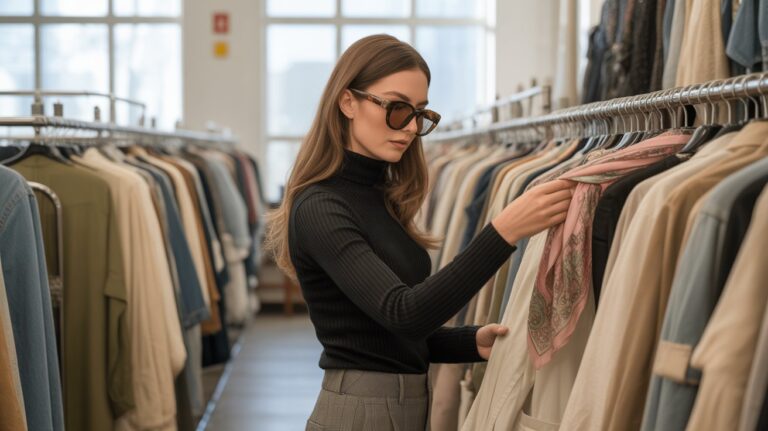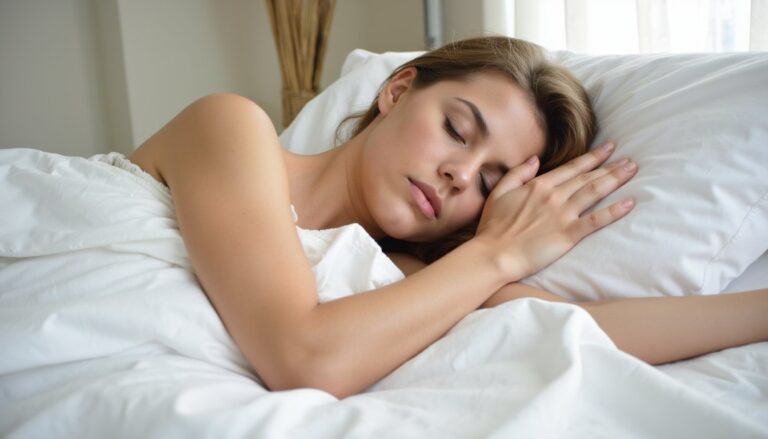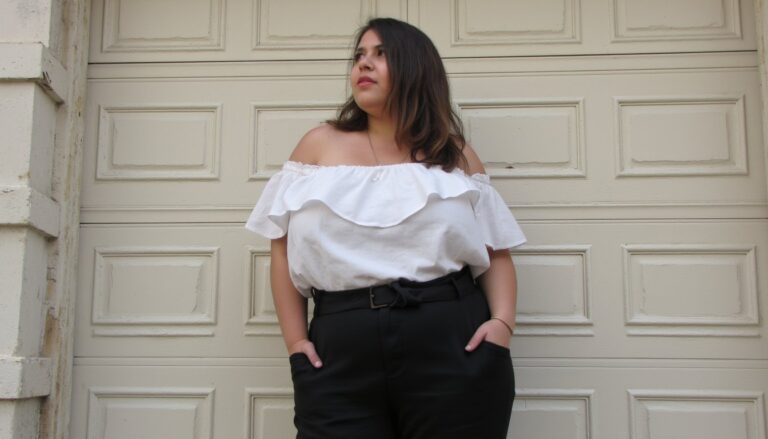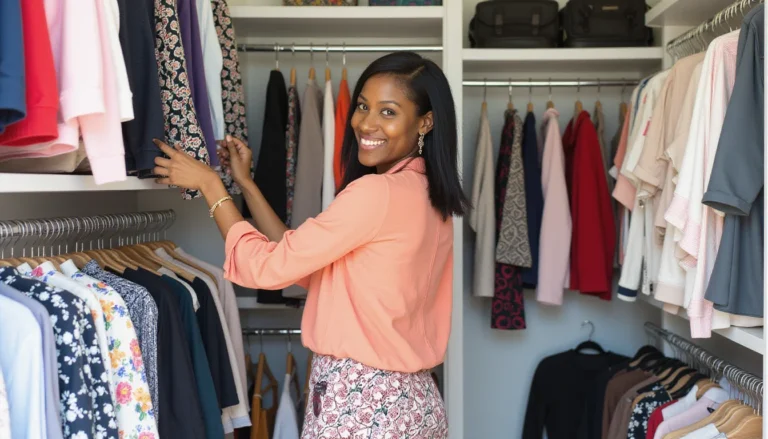How to Make Cheap Clothes Look Expensive: Proven Styling Secrets That Actually Work
Transform your wardrobe from budget to boutique with these proven styling secrets that fashion insiders use to create million-dollar looks without the price tag.
Looking expensive doesn’t require an expensive wardrobe. In fact, some of the most stylish people you admire have mastered the art of creating high-end looks using budget-friendly pieces, strategic shopping, and clever styling techniques.
If you’re working with a tight budget or simply prefer to invest your money elsewhere, this comprehensive guide will teach you exactly how to elevate any outfit from bargain to boutique.
The Psychology Behind “Looking Expensive”
Before diving into specific techniques, it’s crucial to understand what makes clothing appear expensive to the human eye. When we perceive something as luxurious, we’re responding to visual cues that signal quality, attention to detail, and intentional design choices.
Research on luxury consumer behavior suggests that owning these items can greatly enhance happiness and self-worth. For many, choosing, purchasing, and retaining luxury goods becomes an intimate experience, offering more than just tangible objects. This emotional connection extends beyond actual luxury items to any clothing that appears expensive.
The Three Pillars of Expensive-Looking Clothing:
- Impeccable Fit – Nothing screams luxury like clothes that look like they were made specifically for your body
- Quality Details – From buttons to stitching, the small elements that separate high-end from mass-market
- Cohesive Presentation – A polished, intentional overall appearance that suggests curation rather than random assembly
The good news? All three pillars can be achieved regardless of your clothing’s original price point.
Reference: Psychology Behind Luxury Purchases – Fashion Law Journal
The Foundation: Quality vs. Price
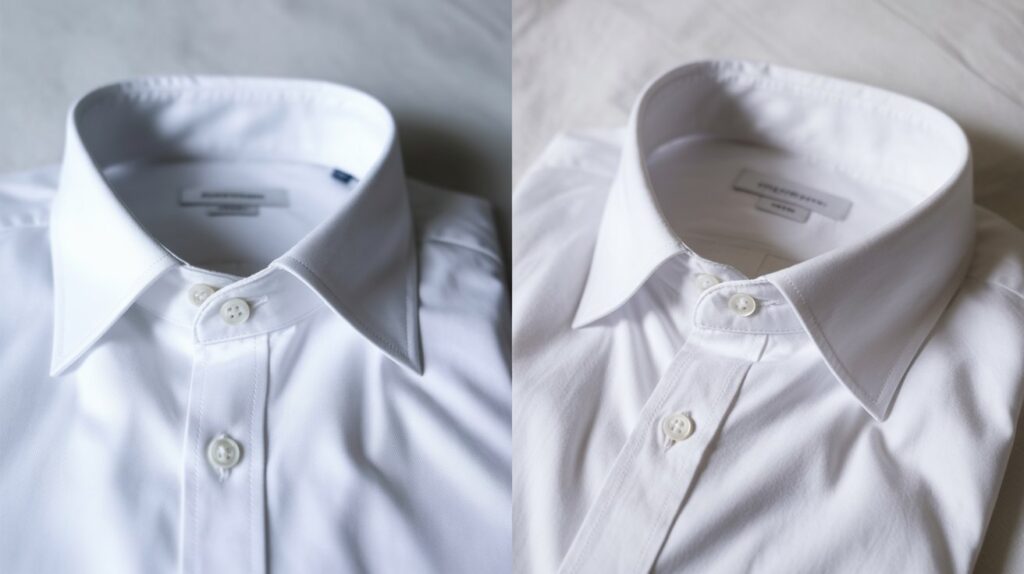
The biggest misconception in fashion is that expensive equals quality, and cheap equals poor construction. While this correlation exists, it’s not absolute. Many affordable brands now use quality construction techniques and materials that were once exclusive to luxury designers.
Studies show that consumer psychology plays a significant role in how we perceive clothing value, with 65% of women and 56% of men feeling their self-confidence is “strongly influenced” by their clothes – regardless of the actual price paid.
Understanding True Quality Indicators
What Makes Clothing Look Expensive:
- Clean, finished seams
- Aligned patterns at seams
- Substantial button and zipper quality
- Even stitching with matching thread
- Quality lining (when present)
- Fabric that drapes well and holds its shape
Red Flags for Cheap-Looking Clothes:
- Visible raw edges or unfinished seams
- Misaligned patterns or prints
- Thin, flimsy hardware
- Uneven stitching or loose threads
- Fabric that wrinkles excessively or loses shape after one wear
- Overly shiny synthetic materials
Fabric Intelligence: Your Secret Weapon
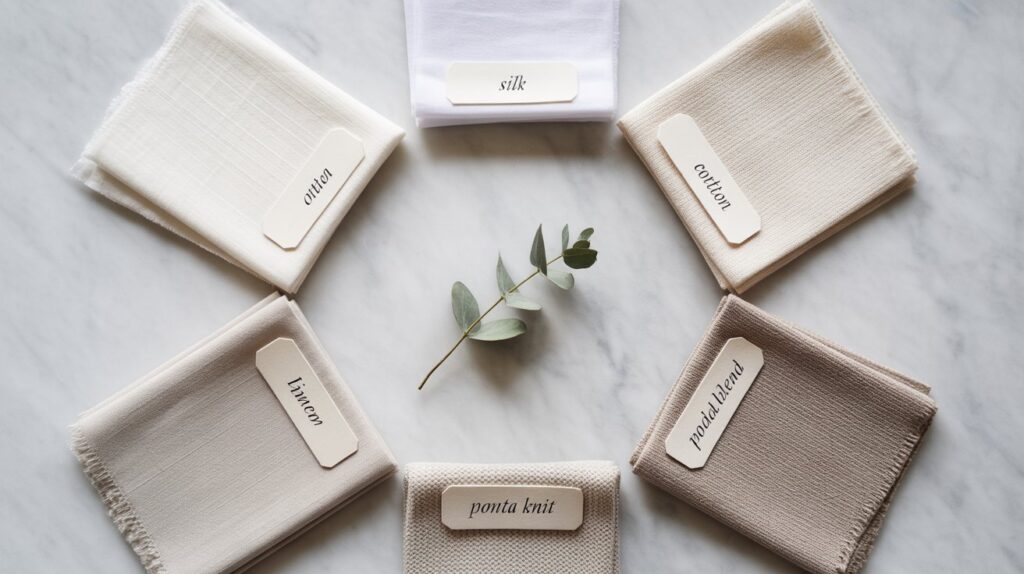
Fabric choice is perhaps the most important factor in determining whether clothes look expensive or cheap. Understanding which materials naturally appear luxurious—regardless of price—will revolutionize your shopping strategy.
High-Impact Fabrics That Always Look Expensive
Natural Fibers (The Gold Standards):
- 100% Cotton – Especially in oxford, poplin, or high-quality jersey
- Linen – Naturally textured and sophisticated, even in budget versions
- Wool Blends – Look for at least 50% wool content for best appearance
- Silk or Silk-Touch Alternatives – Modern polyester silk-alternatives can be indistinguishable from real silk
Budget-Friendly Fabrics That Punch Above Their Weight
Ponte Knit – $15-40 price range
- Why it works: Structured appearance that doesn’t wrinkle easily
- What to look for: Thick, stable knit with good recovery that bounces back after stretching
Crepe – $20-50 price range
- Why it works: Naturally elegant drape that falls beautifully on the body
- What to look for: Matte finish with good weight that doesn’t feel flimsy
Chambray – $25-45 price range
- Why it works: Sophisticated cousin to denim with refined appearance
- What to look for: Even weave that’s not too thin or transparent
Modal Blends – $20-60 price range
- Why it works: Silk-like feel and appearance at a fraction of the cost
- What to look for: At least 50% modal content for best drape and comfort
Stretch Woven – $30-70 price range
- Why it works: Professional appearance with added comfort and movement
- What to look for: Minimal shine with good structure that maintains its shape
Fabrics to Avoid for Expensive Looks
- Overly Shiny Polyester – Screams “synthetic” from across the room
- Cheap Rayon – Pills easily and loses shape quickly
- Low-Quality Cotton – Thin, transparent, or overly soft
- Acrylic Knitwear – Lacks the weight and drape of wool
- Cheap Spandex Blends – Often too stretchy and lose shape
The Power of Proper Fit
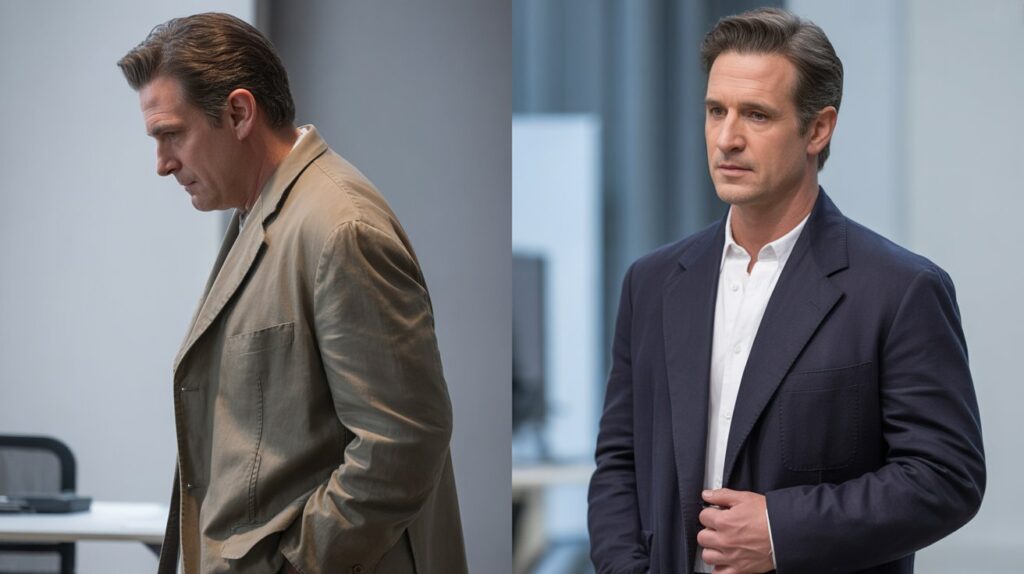
A $10 skirt from Forever21 can end up looking better than a $300 skirt from a designer with just a couple quick stitches. Professional fit is the single most impactful change you can make to any garment.
Research on garment fit and body image shows that well-fitted clothing significantly enhances confidence and self-esteem, with studies demonstrating that proper fit affects not just physical comfort but psychological well-being. Additional research indicates that the effect of apparel fit on body image varies depending on the wearer’s gender, body size, and shape, making personalized fit even more crucial for achieving an expensive look.
Key Fit Points That Make the Biggest Impact
For Tops:
- Shoulder seams should sit exactly at your shoulder point
- Sleeves should end at your wrist bone (long sleeves) or mid-upper arm (short sleeves)
- The hem should hit at your most flattering waist point
- No pulling or gaping across the bust or back
For Bottoms:
- Waistband should sit comfortably without creating bulges
- No pulling across hips or thighs
- Proper inseam length (no bunching at ankles for pants)
- Rise should be appropriate for your body type
For Dresses:
- All of the above rules combined
- Particular attention to armhole fit
- Length appropriate for the occasion and your proportions
When to Tailor vs. When to Pass
Always Worth Tailoring (ROI is High):
- Hemming pants ($10-25)
- Taking in waists ($15-35)
- Shortening sleeves ($15-30)
- Basic hemming on skirts and dresses ($10-20)
Proceed with Caution:
- Letting out garments (limited by seam allowances)
- Adjusting shoulders (expensive and complex)
- Major reconstructions on very cheap garments
Never Worth It:
- Tailoring anything that costs less than the alteration fee
- Fixing fundamental design flaws
- Working with extremely poor quality fabrics
Strategic Shopping: Where to Save and Where to Splurge
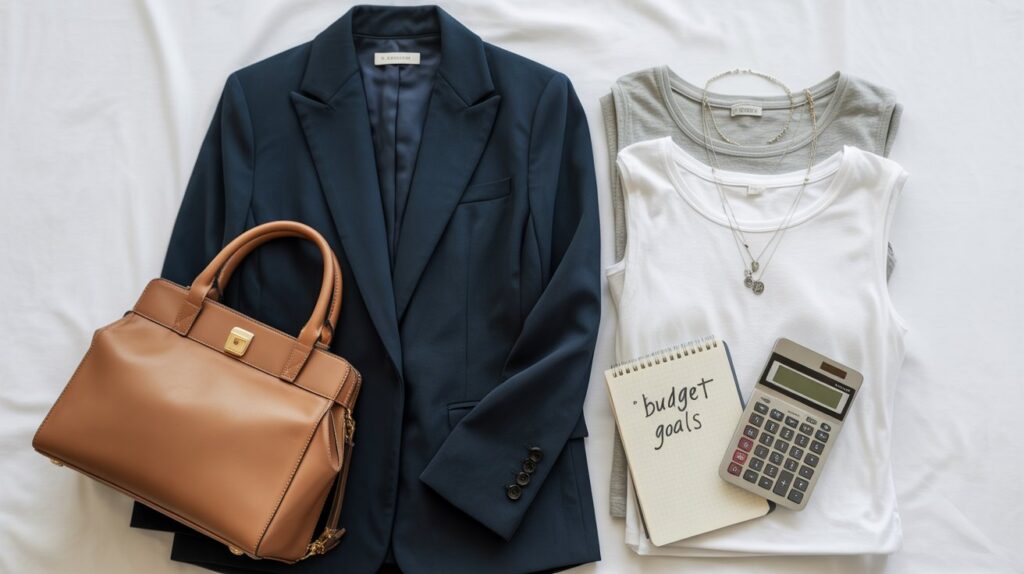
The concept of cost-per-wear helps explain why some expensive items are actually budget-friendly in the long run. However, you can achieve an expensive look by being strategic about where you invest your money.
Research on sustainable fashion consumption patterns reveals that consumers who focus on quality over quantity, combined with strategic shopping approaches, achieve better long-term satisfaction with their wardrobes while spending less overall.
The 70/20/10 Rule for Budget Allocation
70% – Wardrobe Foundation (Save Smart)
- Basic tees, tanks, and undergarments
- Casual jeans and everyday pants
- Simple dresses and skirts
- Basic knitwear
20% – Statement Pieces (Selective Splurging)
- One great blazer
- Quality outerwear
- One pair of excellent shoes
- One standout handbag
10% – Trendy Items (Lowest Budget)
- Seasonal colors and patterns
- Experimental styles
- Accessories that may go out of style
Best Places to Find Expensive-Looking Cheap Clothes
Online Retailers:
- ASOS – Excellent for European-inspired cuts and colors
- Everlane – Minimal aesthetic, transparent pricing
- Uniqlo – Superior basics with Japanese attention to detail
- COS – H&M’s elevated line with architectural silhouettes
Physical Stores:
- Target (A New Day, Wild Fable) – Surprisingly good quality for the price
- Old Navy – Improved significantly in recent years
- T.J. Maxx/Marshall’s – Designer pieces at fraction of cost
- Thrift and Consignment – Vintage luxury at budget prices
25 Styling Techniques That Scream Luxury
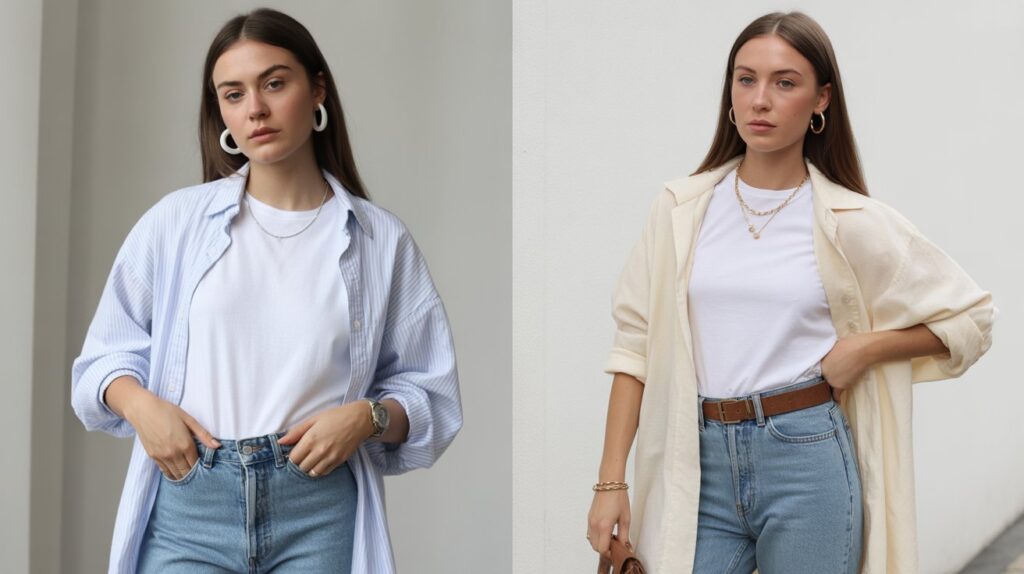
Fashion psychology research indicates that clothing choices significantly impact psychological processes and behaviors, with studies showing that certain styling techniques can influence mood, performance, and confidence – key elements in appearing more expensive and polished.
Color and Coordination Strategies
1. Master Monochromatic Dressing Monochromatic ensembles—especially an all-white outfit—automatically look more expensive. The key is mixing different textures and shades within the same color family.
Pro Tip: Try cream, ivory, and white together, or different shades of gray from charcoal to pearl.
2. Embrace the Power of Neutrals Neutral colors like black, navy, gray, white, and camel look more expensive. Darker solid colors like black hide fabric imperfections on lesser quality fabrics.
3. Apply the 60-30-10 Color Rule
- 60% neutral base
- 30% secondary color
- 10% accent color (through accessories)
Styling and Proportions
4. Perfect the Art of Tucking For anything that doesn’t have a hemline for your tops, or is oversized make sure to do a half-tuck in the front. This creates intentional styling and improves proportions.
5. Size Up Strategically We recently learned the French-girl way to make cheap clothes look more expensive (thank you, Jeanne Damas), and it’s as simple as ordering the next size up to achieve a slouchy, oversize look.
6. Belt Everything Add a belt to your favorite trousers or jeans, or think a bit outside the box and cinch up a blazer or dress with the addition of a waist belt. Belts create structure and intention.
7. Layer Like a Pro
- Thin over thick
- Long over short
- Different textures together
- Never more than three layers total
Detail Work
8. Upgrade Your Hardware Ditch those basic plastic buttons in favor of something a little richer looking, like metal, bone, or mother of pearl. This $5 change can transform a $20 shirt into a $200-looking piece.
9. Replace Cheap Zippers If you’re handy with alterations, replacing a cheap zipper can instantly elevate a garment’s appearance.
10. Add Luxury Linings For jackets and blazers, adding or replacing lining with a quality material changes the entire feel of the garment.
Accessories and Finishing Touches
11. Invest in One Great Bag Even if you’re wearing a pair of jeans and a t-shirt, if youre pairing it with a great bag or pair of shoes, your look will feel more polished.
12. Choose Quality Over Quantity for Jewelry Wearing delicate jewelry pieces in gold or silver tones will elevate your look. Avoid wearing jewelry that is large and more costumey.
13. Perfect Your Nail Game The classic & expensive look requires to wear paster, neutral, or transparent nail polish. Clean, well-maintained nails signal attention to detail.
14. Upgrade Your Sunglasses If you don’t have the budget for designer sunglasses I recommend the brand Quay. They make some great designer dupes that look way more expensive.
Advanced Techniques
15. Create Visual Interest Through Texture Mix different textures within the same color family – think silk blouse with wool pants, or cotton tee with leather jacket.
16. Use the Rule of Thirds Create visual balance by breaking your outfit into thirds – either by color blocking or through proportional layering.
17. Perfect Your Proportions If wearing loose on top, go fitted on bottom and vice versa. Never wear loose everywhere.
18. Add a “Fourth Piece” Adding a 4th piece INSTANTLY completes any outfit and makes it appear polished. Follow this rule each time you get dressed and it will soon become a habit… and you’ll always look rich!
19. Master the Art of Rolled Sleeves Properly rolled sleeves (not pushed up) show intention and attention to detail.
20. Choose the Right Undergarments Bra lines and visible panty lines are distracting and make your clothes look flimsy and ill-fitting. Invest in proper undergarments.
Fabric and Care
21. Steam Everything Wrinkles can make anything look cheap, but ironing is a hassle and many synthetics can’t be ironed. A good steamer can blast wrinkles out of just about anything in a couple of minutes.
22. Maintain Garment Condition If you see a stain and you can’t get it out yourself, immediately take it to a dry cleaner to see what they can do. If nothing can be done, donate it.
23. Store Clothes Properly Hang structured pieces, fold knits, use cedar blocks, and keep everything clean and organized.
24. Choose Matte Over Shiny When in doubt, matte finishes always look more expensive than shiny ones.
25. Pay Attention to Proportional Balance Ensure that your accessories are proportional to your body size and outfit scale.
Budget-Specific Strategies
Under $25 Budget
Focus Areas:
- Basic tees in quality cotton
- Simple accessories (scarves, belts)
- Wardrobe maintenance (steaming, basic alterations)
Shopping Strategy:
- Thrift stores and consignment shops
- End-of-season clearance
- Basic pieces from discount retailers
Key Pieces to Prioritize:
- One well-fitting white button-down ($20-25)
- Quality undergarments ($15-20 each)
- Basic belt in black or brown ($10-15)
$25-50 Budget
Focus Areas:
- One statement piece per season
- Quality basics in neutral colors
- Professional alterations for key pieces
Shopping Strategy:
- Mid-range retailers during sales
- Off-price retailers (T.J. Maxx, Nordstrom Rack)
- Online flash sales
Key Pieces to Prioritize:
- One great blazer ($35-45)
- Quality jeans or trousers ($25-40)
- Classic pumps or flats ($30-50)
$50-100 Budget
Focus Areas:
- Building capsule wardrobe basics
- Investing in outerwear
- Quality shoes and handbags
Shopping Strategy:
- Mid-tier brands during sales
- Investment pieces from discount retailers
- Selective full-price purchases
Key Pieces to Prioritize:
- Classic trench coat or wool coat ($60-90)
- Quality handbag ($50-80)
- Professional-level basics ($40-70 each)
$100+ Budget
Focus Areas:
- True investment pieces
- Premium materials (cashmere, silk, leather)
- Building a cohesive wardrobe
Shopping Strategy:
- Research cost-per-wear extensively
- Buy fewer, higher-quality pieces
- Focus on timeless styles over trends
Maintenance: Protecting Your Investment
Even the most expensive clothes will look cheap if they’re not properly maintained. Make sure to air dry those pieces on a clothing rack. These simple how-to fashion tips will make the quality of your clothes look so much better. Especially when you’re purchasing more budget items.
Daily Maintenance Habits
Immediate Care:
- Hang or fold clothes immediately after wearing
- Treat stains within 24 hours
- Allow clothes to air out before storing
- Use wooden hangers for structured pieces
Weekly Care:
- Steam or press clothes for the upcoming week
- Check for loose buttons or threads
- Rotate seasonal items properly
- Clean shoes and condition leather goods
Professional Care Guide
When to Use Dry Cleaning:
- Wool blazers and coats
- Silk blouses and dresses
- Anything with “Dry Clean Only” labels
- Items with complex construction or embellishments
DIY Care That Works:
- Hand washing delicate items
- Using garment bags for machine washing
- Air drying to prevent shrinkage and fading
- Using fabric shavers to remove pills
Storage Solutions
Hanging Items:
- All structured jackets and blazers
- Dresses and skirts
- Blouses and button-downs
- Anything that wrinkles easily
Folding Items:
- Knitwear and sweaters
- T-shirts and casual tops
- Jeans and casual pants
- Activewear and loungewear
Common Mistakes to Avoid
Shopping Mistakes
1. Buying Items That Don’t Fit Properly Never buy something hoping it will fit after alterations unless you’ve confirmed the alteration is possible and cost-effective.
2. Falling for False Sales Research regular prices before assuming you’re getting a deal.
3. Ignoring Care Instructions If you can’t properly care for an item, it’s not worth buying regardless of price.
4. Choosing Trends Over Timeless Style Trends are temporary and can contribute to your outfit looking cheap. In the fashion world, buying into trendy pieces is one of the quickest way to overspend! Stick to the basics for a timeless & chic wardrobe.
Styling Mistakes
5. Over-Accessorizing More accessories don’t equal more expensive-looking. Choose one or two high-impact pieces.
6. Mismatched Blacks Make sure you don’t wear mismatched blacks (one more faded than the other), as that can look cheap.
7. Neglecting Grooming The most expensive outfit can’t overcome poor grooming. Pay attention to hair, nails, and overall presentation.
8. Ignoring Proportions Clothes that are too big or too small will always look cheap, regardless of their actual price.
Building Your Expensive-Looking Capsule Wardrobe
Your closet basics are the pieces that will make up the foundation of your wardrobe, otherwise known as a Capsule Wardrobe. These are the items that should be your investment pieces.
The Essential 20-Piece Capsule
Tops (6 pieces):
- White button-down shirt
- Black blouse or top
- Quality white t-shirt
- Neutral sweater or cardigan
- Black blazer
- One statement top in your best color
Bottoms (6 pieces):
- Dark wash jeans
- Black pants or trousers
- One skirt (pencil or A-line)
- Neutral dress pants
- One casual skirt or shorts
- Little black dress
Outerwear (3 pieces):
- Classic trench coat
- Warm winter coat
- Casual jacket (denim or utility)
Shoes (3 pieces):
- Black pumps or professional flats
- Quality sneakers or casual flats
- Boots (ankle or knee-high)
Accessories (2 pieces):
- Quality handbag in neutral color
- Classic watch or jewelry pieces
Color Palette Strategy
Choose 3-4 Base Colors:
- One neutral (black, navy, gray, or beige)
- One light color (white, cream, or light gray)
- One accent color that flatters your skin tone
- One seasonal color that can be swapped out
This palette ensures everything coordinates, making you look more polished and intentional.
Seasonal Adaptation Strategies
Spring/Summer Expensive Looks
Key Fabrics:
- Linen and linen blends
- Quality cotton
- Silk or silk-touch materials
- Lightweight wool blends
Color Strategy:
- Fresh whites and creams
- Soft pastels
- Navy and classic brights
- Avoid muddy or faded colors
Essential Pieces:
- Well-fitted white jeans or pants
- Quality cotton dresses
- Lightweight blazers
- Classic sandals or loafers
Fall/Winter Expensive Looks
Key Fabrics:
- Wool and wool blends
- Cashmere or cashmere-feel
- Quality knits
- Structured outerwear materials
Color Strategy:
- Rich jewel tones
- Classic camel and gray
- Deep navy and black
- Avoid anything too bright or summery
Essential Pieces:
- Quality coat or jacket
- Structured knitwear
- Wool pants or skirts
- Quality boots
Shopping Timeline: Building Your Wardrobe Strategically
Month 1-3: Foundation Building
- Focus on fit and basics
- Get existing pieces tailored
- Buy quality undergarments
- Establish color palette
Month 4-6: Adding Structure
- Invest in one great blazer
- Buy quality shoes
- Add outerwear
- Focus on professional pieces
Month 7-9: Expanding Options
- Add variety within your color palette
- Include seasonal appropriate pieces
- Buy accessories that elevate basics
- Focus on special occasion needs
Month 10-12: Refinement
- Replace lower-quality pieces
- Add statement items
- Focus on missing elements
- Plan for next year’s needs
Your Action Plan for Expensive-Looking Style
Looking expensive isn’t about spending more money—it’s about making smarter choices with the money you have. By focusing on fit, fabric quality, and strategic styling, you can create a wardrobe that looks luxurious regardless of your budget.
Your Next Steps:
- Audit your current wardrobe – Identify pieces that already look expensive and those that need improvement
- Get your best pieces tailored – This will have the biggest immediate impact on your appearance
- Establish your color palette – Choose 3-4 colors that work well together and with your skin tone
- Invest in proper undergarments and shapewear – The foundation of every expensive-looking outfit
- Buy one quality piece at a time – Focus on building slowly rather than buying everything at once
Remember, the goal isn’t to look rich—it’s to look polished, intentional, and confident in your personal style. When you feel good in what you’re wearing, it shows, and that confidence is the most expensive-looking accessory of all.
Interactive Budget Calculator
Use this tool to optimize your clothing budget allocation for maximum expensive-looking impact:
🌟 Smart Wardrobe Budget
Optimize your clothing budget using the 70/20/10 rule

